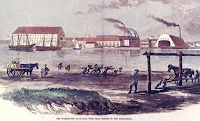 The weather is warming and the Shad are running. Actually they are swimming up the rivers to spawn. The following 14 images [click to enlarge] from the 16th and 19th centuries show the various ways to catch the shad from wiers, spears, nets on sticks and large nets.
The weather is warming and the Shad are running. Actually they are swimming up the rivers to spawn. The following 14 images [click to enlarge] from the 16th and 19th centuries show the various ways to catch the shad from wiers, spears, nets on sticks and large nets. For more on cooking the shad on a plank and recipes see an old post HERE .
"Methods of fishing of the North Carolina Algonquins." Engraving by
Thedor de Bry after a watercolour by John White, 1585. Notice the wiers in the background and spears.
John
White was the artist of this c1590 engraving translated as "How they cook their
fish."
"Fish-nets in the Pedee River" from a photograph [The Fisheries and Fishery Industries of the
United States. George Brown Goode.
Washington: GPO, 1887 p624]
"Shad gill-nets in the Edisto River, South Carolina" from the
same 1887 book.
"The Washington Navy-Yard, with Shad Fishers in the
Foreground" [Harper's Weekly April 20, 1861]
Planking shad at
Marshall
Hall, Maryland, on the Potomac,1893
Shad
Fishing at Gloucester on the Delaware River by Thomas Eakins 1881 [Philadelphia Museum of Art]
Shad
Fishing at Gloucester on the Delaware River by Thomas Eakins 1881 [David Owsley Museum of Art]
Taking
up the Net by Thomas Eakins 1881 [watercolor at The Metropolitan Museum of Art]
“American Sketches: Shad-fishing on the Hudson” [The Illustrated London
News. Aug 7, 1875]
Nets could be very large - this one was a half a mile. 1905.
Great amounts of fish were caught in the nets, ?1915
SHAD! BUY ANY SHAD? 1850
"The shad season commences in the latter part of the month of March. The
first supply comes from the south, and is sold at a pretty high rate. But not
many days elapse before these fishes make their appearance in our rivers, and
then the shad women commence their perambulations and cries in the streets.
Shad are obtained in large quantities, in the spring and summer
seasons, all along the coast of the United States, from Georgia to Maine. The
shad is a large species of herring, which inhabits the sea near the mouths of
large rivers, and in the spring ascends them for the purpose of depositing its
spawn in the shallow waters about their sources. The young fry remain for a
season in the waters which gave them birth, but on the approach of cold
weather, descend the rivers, and take refuge in the ocean. The old ones return
likewise, but at this time are emaciated, and unfit for food. The shad which
frequents our American waters is supposed to be of a different species from the
European. It usually weighs four or five pounds, but sometimes twelve. During
the season, they are an important source of profit to the inhabitants on the
shores of the Connecticut, the Hudson, Delaware, and Chesapeake. Great
quantities are preserved by salting and smoking, but are much less esteemed
than when eaten fresh." [City Cries, or a peep at scenes in town. Philadelphia: New York: 1850]
The shad image is from First Annual Report of the Commissioners of Fisheries, Game, and Forests of the State of New York (1896).
©2013 Patricia Bixler Reber
hearthcook.com

















No comments:
Post a Comment